Got a New Car? A Few Tips That You May Not Have Known:
In the last two years, the automakers have done whatever they could in order to sell new cars. Zero percent financing, tires-for-life and free Maintenance for the life of the vehicle are several of the enticements they have offered to get us to purchase a new vehicle. And needless to say, some of them are very good deals. But beware of a few things the dealers are doing to keep you coming back:
1. Some dealers are telling customers that they must have their new vehicles serviced at their dealership in order to keep the warranty in effect. This is absolutely false! The Magnusson-Moss Warranty Act of 1975 expressly forbids manufacturers from requiring you to return to their dealerships for normal Maintenance work as long as the parts used in the repair or Maintenance equal or exceed OEM (original equipment manufacturers) quality. At Anderson Automotive, we use top quality CARQUEST parts and Imperial Oil products in nearly every repair we perform, and they all meet or exceed OEM specifications.
2. Several dealers offer a “free Maintenance for the life of the vehicle” package to keep you coming back to them. A couple of things I have heard concerning those plans cause me concern. The first is that they only use the manufacturer’s Maintenance schedule for the “free” service, which means most are offering a “free” oil change only every 7,500-10,000 miles. At Anderson Automotive, we have replaced more engines in the past two years than in the seven previous years, and I firmly believe it is because people are actually waiting 7,500 miles before they change their oil! Toyota (which I believe is one of the best vehicles on the road) is replacing/rebuilding engines right and left because they are sludged up. The second thing the dealer might do is offer you their “dealer recommended Maintenance” for an additional fee. This is usually just the good regular Maintenance that we have been offering for years.
So if you have bought or are thinking of buying a new car, please make sure that your new vehicle gets the preventive Maintenance it needs and deserves.
Frequently Asked Questions:
What do I need to know about my battery?
Batteries can fail for a number of reasons, including insecure mounting, frequent “deep cycling” (running the battery very low, then recharging it) and dirty or poor connections. Here are a few ways to help prevent your battery from failing and leaving you stranded:
- Have the battery electrolyte level checked with every oil change (if not a sealed battery).
- Cables should be securely attached and free of corrosion. A simple mixture of baking soda and lots of clear water will neutralize most acid and corrosion.
- Don’t wait until your battery fails before you replace it. Even though they have five-, six- and seven-year warranties, most batteries actually last between three and four years. Also, a weak battery can cause alternators to work too hard and fail prematurely.
- Keep fuel and ignition systems maintained so your engine starts easily and doesn’t discharge the battery from cranking over and over without starting.
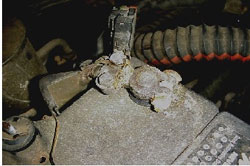 |
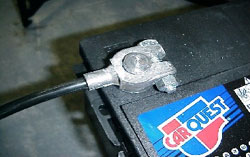 |
How often should my brake system be inspected?
What type of brake pads should be put on my vehicle?
My brake pedal is very low. What could be causing that?
My brake pedal pulsates and my steering wheel shakes. What could be causing that?
My ABS light comes on and sometimes goes off. What could be causing that?
I hear squealing when using my brakes. What could be causing that?
- Worn brake pads/shoes
- Wrong brake pads/shoes
- Improper rotor finish
- Lack of lubrication
- Worn- out hardware
- Fatigued brake shoe hold-down springs
How often should the brake fluid on my vehicle be changed?
What items should I carry in my vehicle?
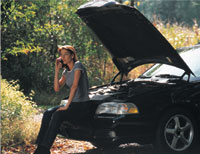 Whether you’re making a quick trip to the grocery store or taking a vacation trip across the country, the No. 1 rule of driving always applies – Expect the Unexpected!
Whether you’re making a quick trip to the grocery store or taking a vacation trip across the country, the No. 1 rule of driving always applies – Expect the Unexpected!
It’s a good idea to prepare yourself and always have certain information, tools and emergency supplies in your vehicle:
- Spare tire
- Jack and lug wrench
- Jumper cables
- Cellular phone and charger
- List of emergency phone numbers
- Flares or reflectors
- Flashlight and batteries
- Help or distress sign
- Maps
- Small tool set
- Rags or paper towels
- Fire extinguisher
- Jug of clean water
- A first-aid kit
- A supply of regularly-taken medication
- Shovel
- Tow rope
- Snow brush/ice scraper
- Sand, cat litter or traction mats
- Tire chains
- Can opener
- High-energy food such as canned fruit or nuts
- Warm clothing
- Blankets
- An envelope in your glove compartment containing vehicle registration, insurance paperwork and vehicle repair receipts
With luck, you’ll never need to use these items, but if you do, they can be both timesavers and lifesavers!
Why do we need fuel injection service?
- Engine pinging
- Poor acceleration
- Hesitation or lurching
- Lack of or poor performance
- Repeated stalling
- Rough idle
- Poor fuel mileage
A fuel carbon cleaning system process will remove carbon deposits from your vehicle’s fuel system, injectors, intake valves and combustion chamber. This cleaning process will not damage your vehicle’s fuel system or engine components. A typical fuel injection service will include the following procedures:
- Clean fuel injectors
- Clean throttle body air intake
- Inspect fuel lines and fuel rail
- Pressure test fuel pump and system
- Inspect pressure regulator, vacuum line and all connections
- Decarbonize intake manifold, intake and exhaust valves
- Decarbonize combustion chamber and pistons
- Run a exhaust emissions test
What are the benefits of fuel injection service?
- Saves you money – improves fuel mileage and heads off costly repairs
- Reduces the risk of breakdowns
- Contributes to the overall performance of your vehicle
- Reduces air pollution
- Increases safety and dependability
- Prevents you from voiding your warranty
Why do preventative maintenance?
How do I communicate for better automotive service?
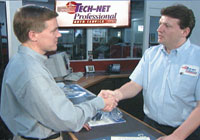 Communication between car owners and repair shops is essential. Anderson Automotive recommends that car owners do their homework before taking their vehicles in for repairs, learn to recognize warning signals and know what to do and say once inside the repair establishment. Do your homework before taking your vehicle in for repairs or service.
Communication between car owners and repair shops is essential. Anderson Automotive recommends that car owners do their homework before taking their vehicles in for repairs, learn to recognize warning signals and know what to do and say once inside the repair establishment. Do your homework before taking your vehicle in for repairs or service.
- Read the owner’s manual to learn about the vehicle’s systems and components
- Follow the recommended service schedules
- Keep a log of all repairs and service
Use your senses to inspect your car frequently for:
- Unusual sounds, odors, drips, leaks, smoke, warning lights, gauge readings
- Changes in acceleration, engine performance, gas mileage, fluid levels
- Worn tires, belts, hoses
- Problems in handling, braking, steering, vibrations
Note when the problem occurs.
- When did the problem first start?
- Is it constant or periodic?
- When the vehicle is cold or after the engine has warmed up?
- At all speeds? Only under acceleration? During braking? When shifting?
Once you are at the repair establishment, communicate your findings.
- Be prepared to describe the symptoms. (In larger shops, you’ll probably speak with a service writer or service manager rather than with the technician directly.)
- Carry a written list of the symptoms to give to the technician or service manager.
- Resist the temptation to suggest a specific course of repair. Just as you would with your physician, tell where it hurts and how long it’s been that way, but let the technician diagnose the problem and recommend a remedy.
- Don’t rush the service writer or technician to make an on-the-spot diagnosis. Ask to be called and apprised of the problem, course of action and costs before work begins. Do not be embarrassed to ask questions.
- Before you leave, be sure you understand all shop policies regarding diagnostic fees, labor rates, guarantees and acceptable methods of payment.
- Leave a telephone number where you can be reached
How do I improve my gas mileage?
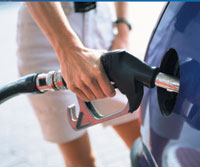 With today’s high gas prices, it’s worth taking a few minutes out of your day to make minor modifications that will improve your gas mileage.
With today’s high gas prices, it’s worth taking a few minutes out of your day to make minor modifications that will improve your gas mileage.
Vehicle Tips
- Keep your tires properly inflated and check them frequently.
- Keep your front suspension and steering in proper alignment.
- Use the thinnest viscosity oil that your car’s manufacturer recommends.
- Keep your engine in proper mechanical condition.
- Keep your engine in tune and make sure the air and fuel filters are clean.
- Make sure your brakes are not dragging.
- Repair body damage. That crunched front fender adds aerodynamic drag – just ask any race car driver.
- Don’t use premium fuel if your car does not require it; using it is an unnecessary expense.
- Don’t waste your money on those late night “as seen on TV” products that are supposed to increase your mileage.
Driving Tips
- Avoid excessive warm-up time. Modern engines do not require it.
- Don’t idle your engine for long periods. Turn off your engine when you leave the car or have to wait a long time.
- Avoid jackrabbit starts.
- Keep your speed at 95 kilometers per hour or less whenever possible.
- For newer vehicles with aerodynamic designs, close the windows and turn on the air conditioning when driving on the freeway.
- For older cars with inefficient air conditioning compressors, use the ventilation system and close the windows, temperature permitting.
- Anticipate merging traffic and stoplights – decelerate and accelerate smoothly.
- Plan your trips wisely. If you need to go to several places, plan a route that allows you to run most or all of your errands in one outing.
- Empty the trunk! Extra clothes, overdue library books, tools and the bag of aluminum cans that you have been meaning to take to the recycler all weigh down your car unnecessarily. Car-pool whenever possible or practical.
- Listen to radio reports for alternate routes around congested areas.
- Drive in the highest gear possible.
Try to keep your speed constant. Use cruise control when on long stretches of road.
How do I keep my car as environmentally-friendly as possible?
 Keep Your Engine Tuned Up
Keep Your Engine Tuned UpA misfiring spark plug can reduce fuel efficiency as much as 30 percent. Follow the service schedules listed in your owner’s manual. Replace filters and fluids as recommended. Check Your Tires Check your tires for proper inflation. Underinflation wastes fuel – your engine has to work harder to push the vehicle. Wheels that are out-of-line (as evidenced by uneven tread wear or vehicle pulling) make the engine work harder, too. Properly maintained tires will last longer, meaning fewer scrap tires have to be disposed.
Every 10 days, motorists who drive with under-inflated tires and poorly maintained engines waste 70 million gallons of gasoline. -Car Care Council
Service Your Air Conditioner
Keep your air conditioner in top condition and have it serviced only by a technician who has been certified to handle/recycle refrigerants. Air conditioners contain CFCs – gases that have been implicated in the depletion of the ozone layer. According to the Environmental Protection Agency, almost one-third of the CFCs released into the atmosphere come from mobile air conditioners; some simply leak out, but the majority escape during service and repair so it’s important to choose a qualified technician.
“Each year 20 times the amount of oil spilled by the tanker Exxon Valdez in Alaska is improperly dumped into America’s environment by do-it-yourselfers.” -Automotive Information Council
Attention Do-It-Yourselfers
Dispose of used motor oil, antifreeze/coolant, tires and old batteries properly. Many repair facilities accept these items. Or call your local municipal or county government for recycling sites. Never dump used oil or antifreeze on the ground or in open streams.
Observe Speed Limits
Gas mileage decreases sharply above 55 mph or 95 kph. Avoid sudden accelerations and jerky stop-and-go’s. Use cruise control on open highways to keep your speed as steady as possible.
Avoid Excessive Idling
Shut off the engine while waiting for friends and family. Today’s vehicles are designed to warm up quickly, so forget about those long warm-ups on cold winter mornings.
Remove Excess Items
Remove excess items from the vehicle. Less weight means better mileage. Store luggage/cargo in the trunk rather than on the roof to reduce air drag.
Plan Trips
Consolidate your daily errands to eliminate unnecessary driving. Try to travel when traffic is light to avoid stop-and-go conditions. Join a car pool.
Remember, how your car runs, how you drive it and how its fluids, old parts and tires are disposed of all have serious impacts on the environment.
It’s Up to You: Dirty or Clean
Car care is definitely a win-win situation. Besides helping the environment, a properly maintained and operated vehicle will run more efficiently, will be safer and will last longer – up to 50 percent longer – according to a survey of ASE-Certified Master Auto Technicians.
These tips should put you on the road to environmentally-conscious car care.
What do I need to know about Winter driving?
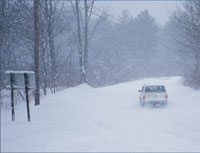 The winter months will be here before you realize. Fall is the best time to have your vehicle inspected for any needed Maintenance work. Snow, ice and cold temperatures are just some the problems your vehicle will encounter. Here are some tips that can reduce your chances of an unexpected breakdown and keep you safe through the winter months:
The winter months will be here before you realize. Fall is the best time to have your vehicle inspected for any needed Maintenance work. Snow, ice and cold temperatures are just some the problems your vehicle will encounter. Here are some tips that can reduce your chances of an unexpected breakdown and keep you safe through the winter months:
- Inspect belts and hoses; if they are more than four years old they may have to be replaced.
- Check antifreeze protection: important in preventing engine freeze-ups.
- Check tires and tire pressure: Good tires are essential on those snowy and icy roads.
- Check all lights and fluid levels.
- Check and/or replace wipers (consider snow blades).
- Add windshield washer fluid that’s better in cold temperatures.
- Have the exhaust system checked; exhaust leaks will cause harmful carbon monoxide gas to leak into the passenger compartment.
- Have your heater and defroster checked.
- Check to see that all Maintenance services are up to date.
- If your battery is more than four years old, have it tested. An old or borderline battery may fail in extreme cold.
- Carry with you a winter emergency kit consisting of: a flashlight, gloves, hat, flares, blanket, small amount of sand or salt, drinking water, snacks, cell phone, ice scraper and a small shovel. Drive cautiously and slow over icy, snowy or leaf-covered roads.
- Make sure your vehicle is mechanically sound before the temperature dips and the streets get icy.
Simple low cost maintenance now is much better than a major repair later.
How do I prepare my car for a Summer trip?
- Make sure your tires are properly inflated. Using an air pressure gauge, be sure that your tire pressure meets the manufacturer’s specifications, as listed in the owner’s manual.
- Check your oil. It’s a good habit to check your motor oil before every trip. If it’s low, or due for a change, your engine is in danger of overheating.
- Monitor your coolant and water levels. Overheating can also occur if your engine’s coolant or water level is too low, so both should be regularly checked.
- Test your battery. Summer temperatures can shorten the life of your car’s battery. Before taking a trip, weak or old batteries should be tested and replaced if necessary.
- Test your vehicle lights and turn signals. Check your vehicle’s lights, including all headlights, brakelights and turn signals, to make sure they work properly.
- Clean your vehicle lights. It is important to see and be seen. Built-up residue, such as pollen or dirt, may cause your headlights to become dim.
- Check your wiper blades. The weather does not always cooperate while you’re traveling. Remember to check your wiper blades on both sides to ensure tight attachment and a clean blade surface.
- Clean your windshield and windows. Regularly clean your windshield and windows on both the inside and outside to reduce glare and improve visibility.
- Don’t overload your car. When packing your car for a trip, overloading can create excessive tire heat, which can lead to blowouts. In addition, overloading your backseat or storage area can limit visibility.
- Have emergency equipment accessible. Make sure you leave room in your trunk for the following safety items: a tire gauge, flashlight with extra batteries, flares or reflectors, fire extinguisher and first-aid kit.
What is the best way to get maximum efficiency from my air conditioner?
What about that musty odor?
Not much air is coming through the vents. What's wrong?
What should I do in Spring to prepare for Summer driving?
 Spring is one of the prime times for auto maintenance. That first wash-n-wax on a warm Saturday afternoon is liberating. Winter’s gloom (to say nothing of grit and road salt) is literally washed away. Take out the snow shovel, the gloves and heavy boots and store them ’til next season. Surely summer can’t be far away.
Spring is one of the prime times for auto maintenance. That first wash-n-wax on a warm Saturday afternoon is liberating. Winter’s gloom (to say nothing of grit and road salt) is literally washed away. Take out the snow shovel, the gloves and heavy boots and store them ’til next season. Surely summer can’t be far away.
Some preparation now will help ensure that your summer driving plans go as smoothly as you envision then now. Anderson Automotive offers the following tips on getting your vehicle ready for summer:
- Read the owner’s manual and follow the recommended service schedules.
- Have hard starts, rough idling, stalling, etc., corrected before hot weather sets in.
- Flush and refill the cooling system (radiator) according to the service manual’s recommendations. The level, condition and concentration of the coolant should be checked periodically.
- If you are not a do-it-yourselfer, look for repair facilities that employ ASE-Certified automotive technicians.
- The tightness and condition of belts, clamps and hoses should be checked by a qualified auto technician.
- Have a marginally operating air conditioner system serviced by a qualified technician to reduce the likelihood of more costly repairs.
- Change the oil and oil filter as specified in owner’s manual. (Properly dispose of used oil.) Replace other filters (air, fuel, PCV, etc.) as recommended.
- Check the condition of tires, including the spare. Always check tire pressure when the tires are cold.
- Inspect all lights and bulbs; replace burned out bulbs.
- Replace worn wiper blades and keep plenty of washer solvent on hand to combat summer’s dust and insects.
What's that light on my dash called "check engine?"
As far back as the early 80’s car companies have used on-board computers to control and monitor various engine systems. Computers now control fuel, ignition, pollution and other vehicle systems which were once mechanical. The purpose of this technology is to decrease air pollution, maintain good fuel economy and to increase the overall efficiency of the modern automobile. With this technology comes the need to have a system where-by the computer can actually check itself and help in the diagnostic process should a problem occur. For this reason, the “check engine” light was incorporated as part of a warning system on your dashboard.
When the check engine light is on, the vehicle’s on-board computer system is telling you that there is a problem. Many times the problem will be minor. The problem may fuel related, electrical, ignition, engine or pollution related. Most problems may be simple in nature but may take sophisticated diagnostic procedures to identify. Don’t be fooled by a “free” check engine light diagnosis. With the amount of knowledge and high-tech equipment needed to diagnose a vehicle’s on-board computer system it would be in your best interest to pay a trained professional to analyze your problem.
Intermittent glitches can also occur which can turn on the check engine light. These problems can be very difficult to solve and may even require your vehicle’s on-board computer to be updated or re-programmed. You should always have a trained automotive technician test your on-board computer when the check engine light comes on, even if you don’t experience any obvious problems.
How do I hook up jumper cables?
The procedure is simple: Connect the positive (+) clamp to the positive terminal of the healthy battery and the other positive clamp to the corresponding terminal of the dead battery. Next, the negative (-), or ground, terminal on the good battery and, finally, the negative clamp to the engine block, frame or other grounded metal as far as possible from the battery. You want to avoid sparks in the vicinity of the explosive hydrogen gas that emits from the battery. Do not connect it to the ground terminal.

